So, you want to start a business?
Strike out into the unknown?
Discover new opportunities?
Change the world with your hyper-realistic food-themed jewelry? (I don’t know about you, but my world has certainly been…changed.)
And, maybe even make some money along the way?
The road to building a successful business and becoming your own boss can be a long one. Luckily, we have a map.
In this complete guide, you’ll learn all the steps that you need to start a successful small business, from creating a basic business plan to hiring your first employee.
Grab a snack (of the non-necklace variety), and let’s hit the road.
Refining the Big Idea
Every creative endeavor has two halves: the idea and the execution.
Many aspiring entrepreneurs come up with awesome ideas, but end up struggling with the second part.
Need proof? How many friends of yours have revolutionary app ideas? And how many have actually developed an app, released it, and built a successful business out of it? Chances are, the answer to the second question is a lot lower.
When you start your own business, you have to get beyond the big idea to crafting your execution plan.
So, let’s start things off on the right foot and break your big idea down into small, achievable steps.
1. Define Your Business Idea
Few things kill a new business like a concept that’s way too vague. How do you even start building your business if your plan is simply to “make a new type of social network?”
Well, you don’t. You either refine your idea into something tangible, or let it languish over time.
Most ideas can be saved with a dash of refinement and a bit of polish. The key to doing so is asking the right questions:
- Why are you starting this venture?
- Who is your target demographic, and is that a viable market?
- What product or service are you offering?
- When will it be available, and when would someone use this product?
- Where will your product be available?
By answering these questions, you can turn a vague idea like “start a new social network” into “start a new social network for US-based professionals and recent college graduates to connect and find job opportunities in their alumni networks.”
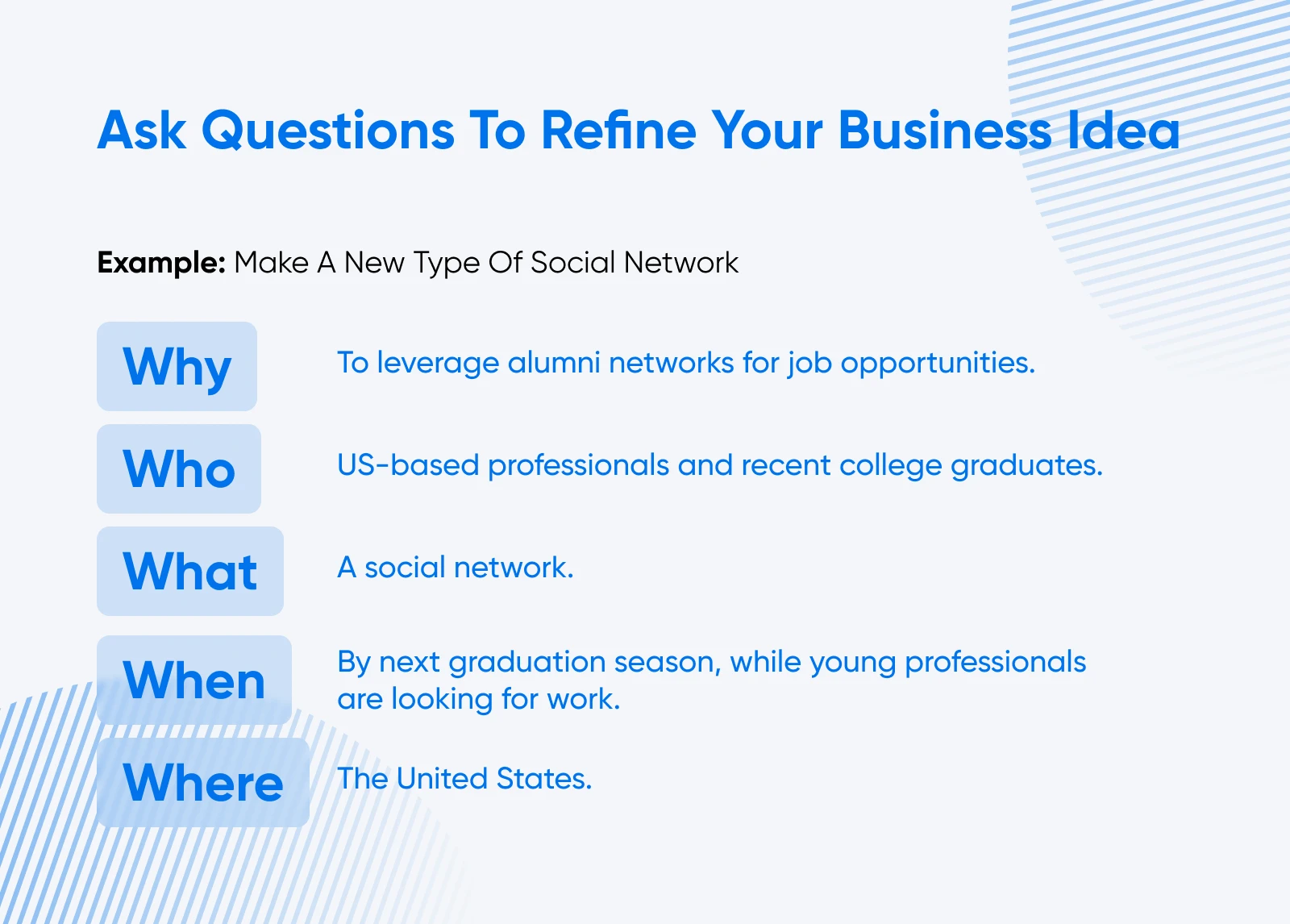
Once you get through your first round of questions, ask more: Why would this niche market use this over LinkedIn? What are the features that separate it from the competition?
Refining your idea is like making a sculpture out of a block of marble. Start by cutting away big chunks on your first pass, and then chip at the little details once you’re further along.
Remember, sometimes ideas simply don’t work. It’s just as important to know when to give up on an idea as how to refine it. After some chipping, there’s no shame in admitting that a certain direction isn’t a good one. Put it to the side so you can focus your efforts on another big idea.
2. Create A Business Plan
The next step is to start working out the fine details by developing a detailed business plan. Besides serving as a guide, your business plan can also come in handy when looking for investors or business grants.
According to the U.S. Small Business Administration, a business plan should have these elements:
- Executive summary: Sum up your business. Why will it be successful? What is your mission statement? What are you offering? In short: Who are you as a business, and why should anyone care?
- Company description: Expand on some of the most interesting points in your executive summary. What problems does your business solve? What is your team like? What’s your competitive advantage? Your company description will likely overlap with your executive summary to some extent, but you can expand on it and add new information here as well.
- Market analysis: Explain how your product fits into the target market. What are competitors doing? How can you do it better or cheaper?
- Service/product line: Describe the products or professional services you’re selling. Include information about patents, lifecycle, benefits, and even business location if that’s critical. This information will form the backbone of your business model.
- Marketing and sales details: Explain how your sales and marketing efforts will work. How will you grow your customer base? How will you retain customers?
- Funding request: If you’re using this plan in an investor meeting, include information about how much funding you’ll need over the next five years and what you plan to use that money for.
- Financial projections: Prove that your business is in good financial health and ready for success by including your financial plan and projecting what your finances will look like in the next few years. Keep in mind you may also want to include an income statement here if you’re already up and running.
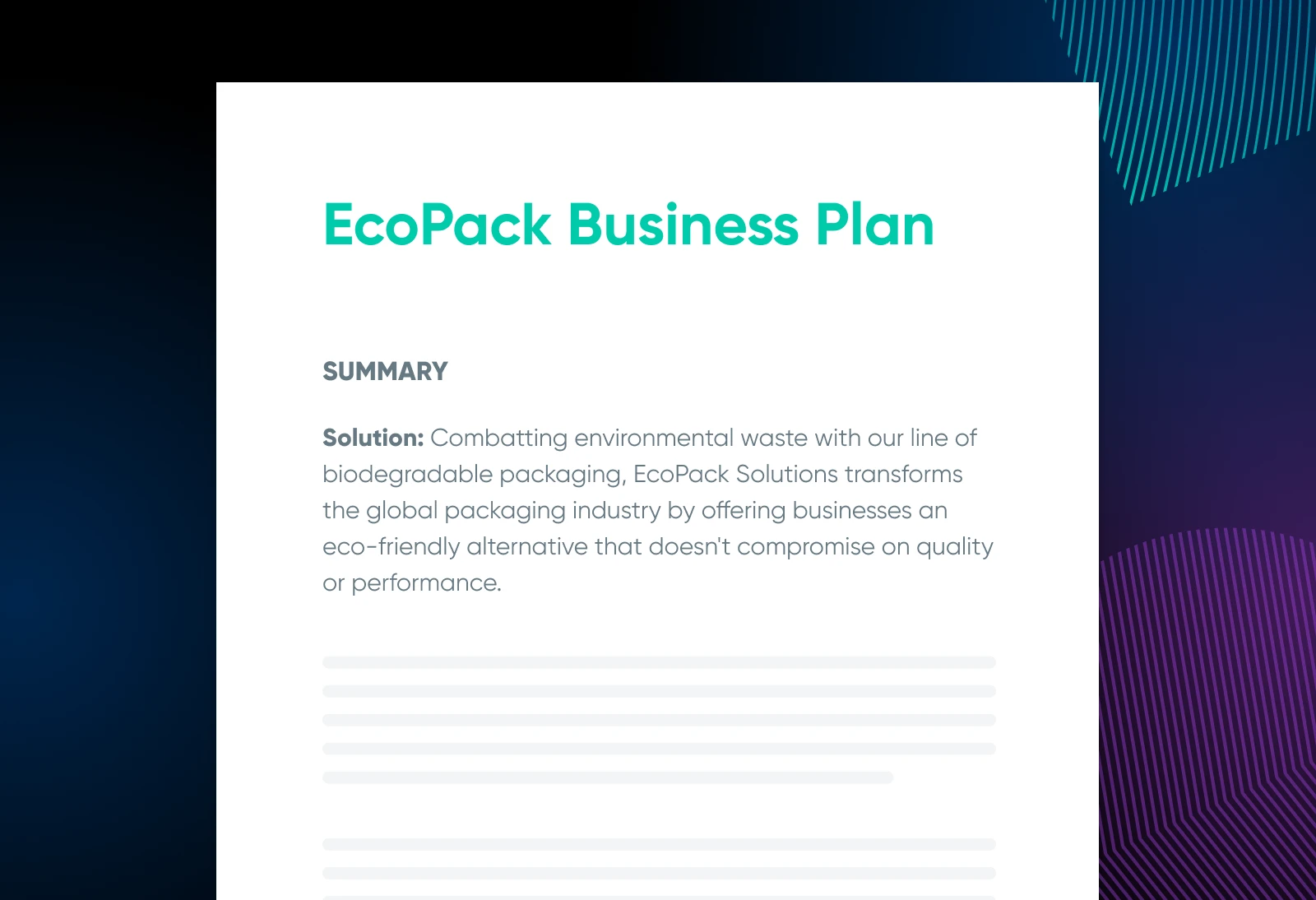
Once you have all the information you need, we’ve created a business plan template that you can download and fill out.
3. Decide On A Business Name
Chances are that if you’ve made it this far, you already have some type of working name. If you don’t, it’s time to iron one out.
When coming up with your business name, keep these tips in mind:
- The name should be catchy and sound good when you say it out loud
- You should be able to trademark your name
- The name should relate somewhat to your product or service’s benefits or features
- You should be able to get a .com domain for it (more on that next)
- Your name should be easy to spell
Some entrepreneurs get backed up at this stage. While it’s definitely important to make sure your business name has some allure to it, don’t overthink it and hold up your progress just because you can’t settle on the perfect name. Give yourself a reasonable amount of thinking time and then go with your favorite option, even if you’re not completely thrilled with it.
[bng]
4. Flesh Out Your Brand
Like people, businesses can have all kinds of personalities.
Once you’ve settled on a name for your business entity, start to consider what other features and characteristics you want people to recognize your brand by.
At this point, you’ll want to design a logo and set some brand guidelines. What tone will your business take in its communications? What colors represent it?
Oatly, for example, has defined itself through its playful and irreverent copywriting, its funky logo, and its commitment to a soft palette of primarily blue, brown, black, and white.
Ideally, your visual identity should be recognizable enough that when you release a new item, target customers will immediately realize that it’s from your product line.
Securing Your Space On The Web
In our digital-first world, maintaining a strong online presence is more important than ever.
Luckily, starting a website and building a social presence is way easier than it used to be. Here’s how to get rolling!
1. Register Your Domain
Your domain is the address that people will type in when they want to visit your website.
For example, our domain is dreamhost.com. If your business was called Deb’s Donuts, your domain might be debsdonuts.com.
Domain Name
Domain names are like an address for the internet, making it easier to find websites without having to remember a complex string of numbers. They’re also helpful in distinguishing one website from another because each domain name must be unique.
Read MoreThe vast majority of businesses will want to get a .com name. However, other domain extensions, like .ai, .inc, and .net may be worth consideration in certain cases.
Purchasing and registering a domain is a simple process. All you need to do is search for your desired domain on a reputable domain registrar’s website and buy it. Most registrars guide you through the process.
Once you’ve got a domain, you need to connect it to your website. Most website-building platforms offer guidance on how to do this. (Here’s ours.)
Overall, the hardest part about choosing and registering a domain is finding one that isn’t already taken. In some cases, you may need to get a bit creative by adding words, i.e., Deb’s Donuts PDX.
Related: Choosing The Perfect Domain Extension For Your Business
2. Set Up Social Media Accounts
The number of social media users just keeps going up.

To ensure your business’s survival in the modern business climate, you need to be where your potential customers are — on social media.
Don’t worry. You don’t need to actually develop your social media presence just yet. Right now, we’re just setting up usernames. Like domain names, usernames on major social network sites are hot commodities and go fast, so you want to lock them down ASAP.
Unfortunately, it’s fairly unlikely that you’ll end up finding the same username on all social platforms. Most businesses will need to edit their handles slightly or have different accounts per platform (such as @debsdonuts on TikTok and @debsdeliciousdonuts on Instagram).
Related: How To Create A Winning Social Media Strategy
3. Build A Website
What use would your domain name be if you had no website to go along with it? Once you have a domain ready to go, it’s time to start building your website.
These days, there are tons of online website builders that make it easy to get a site up and running quickly.
But if you want your website to run on a powerful, tried-and-true platform, building a WordPress site is one of your best options. WordPress powers over 43% of all websites, so there’s no lack of support, powerful features, and communities to get involved in.
DreamHost offers a drag-and-drop WordPress website builder with shared hosting that combines the ease of a website-building tool with the raw power of WordPress. This gives the business owner the best of both worlds.
Handling Legality And Financials
Starting a business can sometimes mean navigating a lot of red tape. Between registering your business, structuring it, and opening a bank account, many entrepreneurs quickly find themselves with their hands full.
Here are the basics for getting your business off the ground.
1. Find An Accountant And Attorney
If you’re serious about your business’s success, it’s a good idea to start things off on the right foot and hire an accountant and an attorney. Starting a business is a complex process with lots of legal requirements, and this team can guide you through it and answer your questions along the way.
If you’re on a very tight budget or starting your business as a side hustle, you may be able to hold off on this step. But keep in mind that you’re running a risk when you don’t have a professional helping you with complex tax, financial, and legal issues.
Plus, an attorney and accountant will help you figure out how to choose a business structure, which is the next step in your journey. (Having fun yet?!)
2. Decide On A Business Structure
Choosing a business structure is one of the most important decisions you’ll make. The legal structure you choose will determine how you pay taxes and how government entities view your business.
Importantly, your business structure will determine whether or not your profits are taxed on a pass-through (or flow-through) basis. Owners of pass-through businesses count their share of profits as individual, self-employed income, which is subject to income tax. Owners of non-pass-through businesses pay themselves a salary and report their income and the business’s profits separately.
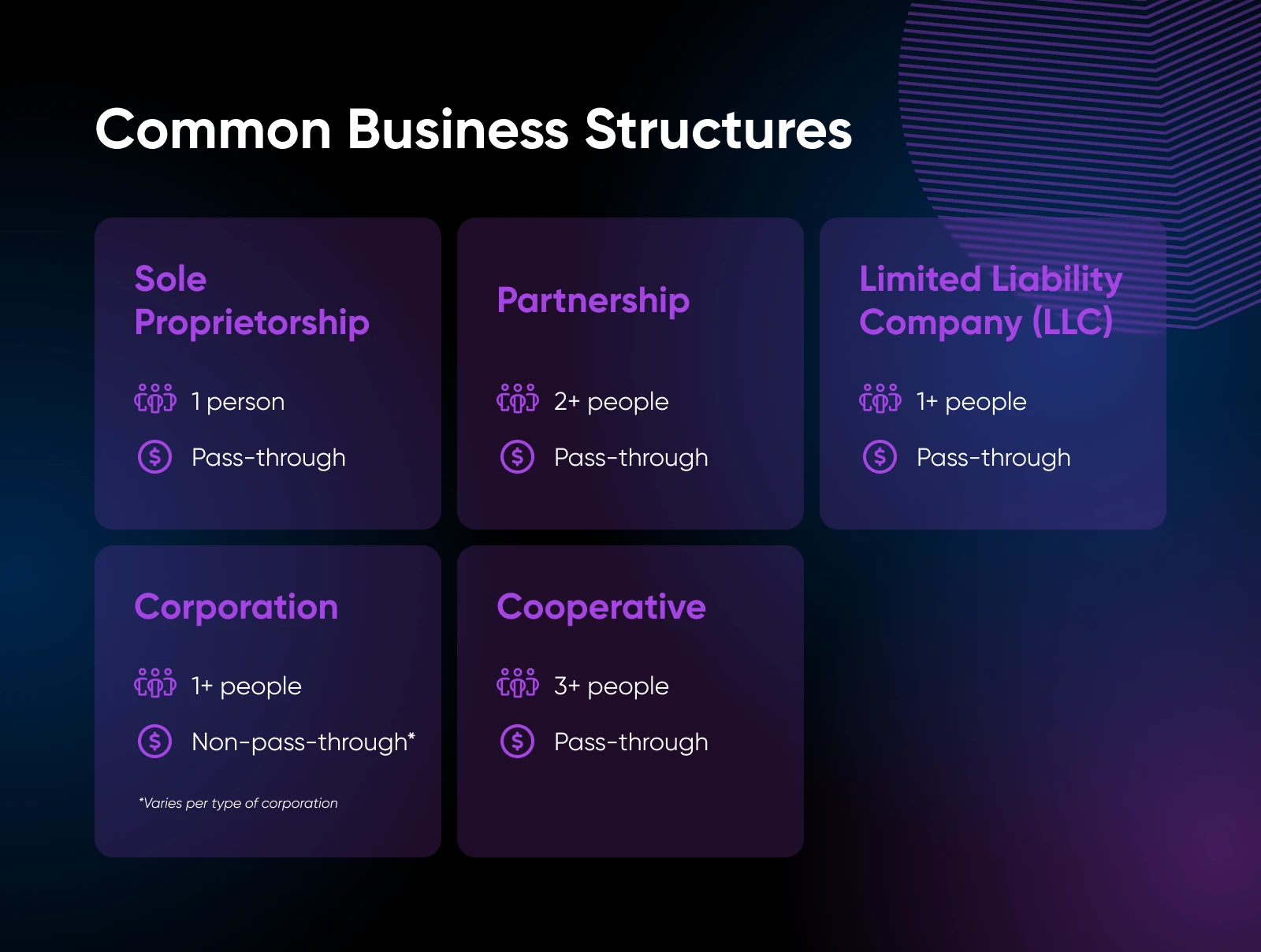
The most common business structures in the U.S. are:
- Sole proprietorship: This structure can be used by businesses without any employees. Any businesses that don’t formally register are automatically considered sole proprietor operations.
- Partnership: Have a business partner? Partnerships are a simple structure for businesses with two or more owners. Profits are taxed on a pass-through basis.
- Limited liability company (LLC): LLCs are among the most popular pass-through structures for small businesses. This structure separates personal and business assets so that you can’t lose your house or car if your business goes bankrupt.
- Corporation: A corporation is a standalone legal entity. Profits are not taxed on a pass-through basis, so owners need to pay themselves a salary. There are several types of businesses in this category, including S Corps (note: this is a pass-through entity), C Corps, and nonprofits (typically tax-exempt, varies by location and designation).
- Cooperative: A cooperative is a business owned and operated by a group of people who use its products or services. These people typically own shares in the company, and profits are distributed amongst them. Some cooperatives are exempt, and others pay taxes like corporations.
Our recommendation is to avoid starting with a hugely complex business structure. As you can see, the ins and outs of business structure and tax compliance are already enough to keep up with.
3. Register With The Government And IRS
Most business registration happens at a state level, so you’ll need to look into your local laws to see what’s required to legally form your business. An attorney can help guide you here.
Once your business is registered, you might need to file to get a federal tax ID called an Employer Identification Number (EIN). Think of an EIN as a Social Security number for your business. According to the IRS, you’ll need an EIN if your business does any of the following:
- Pays employees
- Operates as a corporation of partnership
- Files tax returns for employment, excise, or alcohol, tobacco, and firearms
- Withholds taxes on income, other than wages, paid to a non-resident alien
- Uses a Keogh Plan (a tax-deferred pension plan)
- Work with certain types of organizations (trusts, estates, nonprofits, etc.)
If you’re running a sole proprietorship or single-member LLC, you don’t need a separate tax ID. Your profits are taxed as personal income.
4. Open A Business Bank Account
Having a business bank account just for business expenses helps you separate your personal and business finances, making accounting and filing taxes much easier. It also offers an extra layer of protection for your personal assets, maintains a professional image, and allows you to open a business credit card and checking account.
To open a business bank account, you’ll need to have your formation and tax documents, along with a business license and ownership agreements. Your accountant is a great resource here, especially if you’re considering applying for a business loan.
5. Purchase Insurance
Many business owners forget to take out an insurance policy, or simply don’t realize how important it is. Don’t be one of them.
Insurance can help if your business takes on property damage, or if you get sued for some reason. Plus, if you hire employees, you legally need to have unemployment insurance and worker’s compensation in case anyone experiences illness or bodily injury as a result of the job.
Setting Up Your Daily Operations
A business is like a machine. To keep it running smoothly, you can’t just focus on a few parts (products, marketing, etc.). You need to make sure all the parts are present, working well, and functioning in harmony.
Let’s discuss the other core elements to keep your business engine humming.
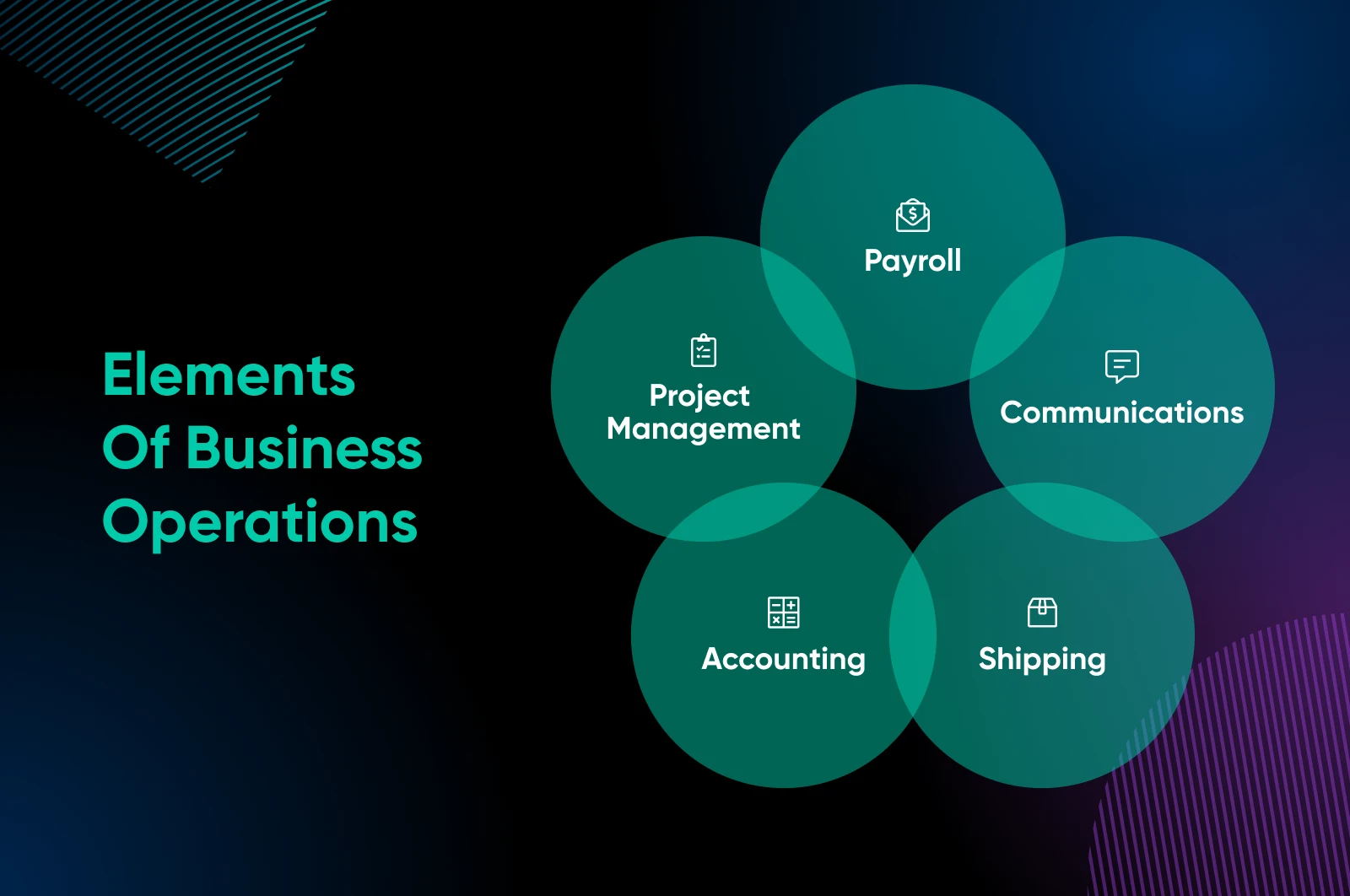
1. Accounting
Your accounting system is the backbone of your business’s financial operations. Without a good system in place, you can’t process invoices, make payments, etc.
For those of us who weren’t mathletes, there are a lot of small business accounting tools on the market. You can also speak with an accountant, who can help you find a solution that works for your specific needs.
2. Project Management
A robust project management program ensures that projects, such as new campaigns and product features, reach completion in a timely and organized way. Project managers use them to communicate with different team members, contract employees, and other external businesses to keep everyone on the same page.
Whether you’re going to be your sole proprietorship’s own project manager or you’re hiring one for your corporation, we recommend you invest in useful business apps like Asana or Trello.
Related: 14 Practical Small Business Apps You Need To Know
3. Payroll
If you plan to hire employees, you need some type of payroll system. Gusto and Bill.com are good options, but there are more on the market if you want to shop around.
If you’re hiring only contractors, a payroll platform is helpful, but not entirely necessary.
4. Communications
Whether you’re hiring employees or contractors (don’t worry, we’ll cover that next), you need a way to communicate with each other.
While email works fine in most cases, many growing businesses prefer powerful, asynchronous platforms like Slack, which speed up communication and are more convenient than email.
5. Shipping (If Applicable)
Businesses that have an e-commerce component need to set up a shipping system. To figure this out, compare options like USPS, UPS, FedEx, and DHL to see which one best fits your needs.
Related: WooCommerce Vs. Shopify: Which Platform Is Right For You?
Hiring Your Team
A business is nothing without its team members. When building your team, you have the choice to mix and match between three types of workers.
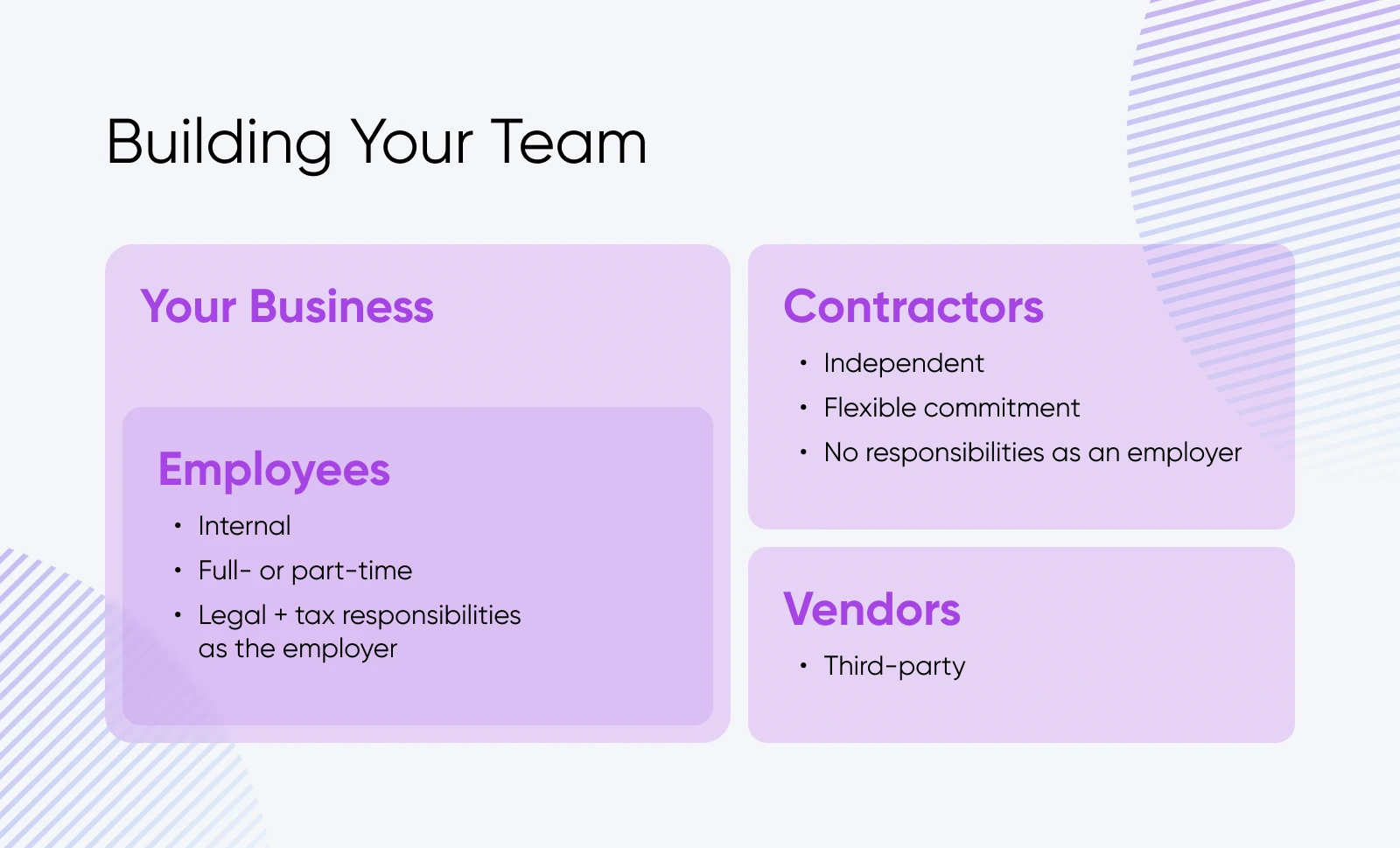
1. Employees
Employees are full-time or part-time workers. Hiring employees comes with a slew of legal and tax responsibilities, such as paying payroll taxes and unemployment insurance.
However, there are also benefits to hiring employees, such as having reliable team members always available during work hours. You also have more control over the work produced.
2. Contractors
Contractors are typically independent businesses themselves, so you won’t have any legal responsibilities as their employer (outside of what’s covered in your contract). You can hire them at will without a long-term commitment.
However, since contractors are independent and not full team members, you won’t have the same level of control over the work they produce. Plus, they may not be available when you need them — they have their own schedules and businesses to run, after all.
Contractors are useful for businesses that need specific deliverables, like graphic design, writing, web development, etc. — but businesses that need operational support may benefit from having actual employees for customer service, management, etc.
3. Vendors
Some businesses choose to outsource elements of their work to third-party vendors. For example, you may choose to hire a third party for on-site security, or a call center to field all your customer service requests.
This is typically only required for larger businesses, but it’s something helpful to keep in mind as you grow.
Speaking of…
Growing Your Business
Once you’ve planted the seeds of your business, here’s how to apply the water and fertilizer so that it grows into a successful startup.
1. Establish A Marketing Strategy
Having a clear marketing plan that outlines how you want to promote your products or services and to whom gives you direction. Direction is critical for saving time and money and staying on the path to growth.
What kind of marketing tactics should be part of your plan? We’ve compiled many of the best advertising and marketing tips and plans for small businesses in the following guides:
In addition to tactics, your marketing strategy should outline what kind of marketing spend you’re willing to shell out, and which marketing analytics tooling you’ll use to track campaign success and ROI.
Related: 30 Affordable Ways To Promote Your Website
2. Set Goals And Create An Expansion Plan
Businesses rarely grow without goals, at least not in the right direction. To ensure your business continues to evolve over time, it’s a good idea to set SMART goals, which are specific, measurable, attainable, relevant, and time-based.
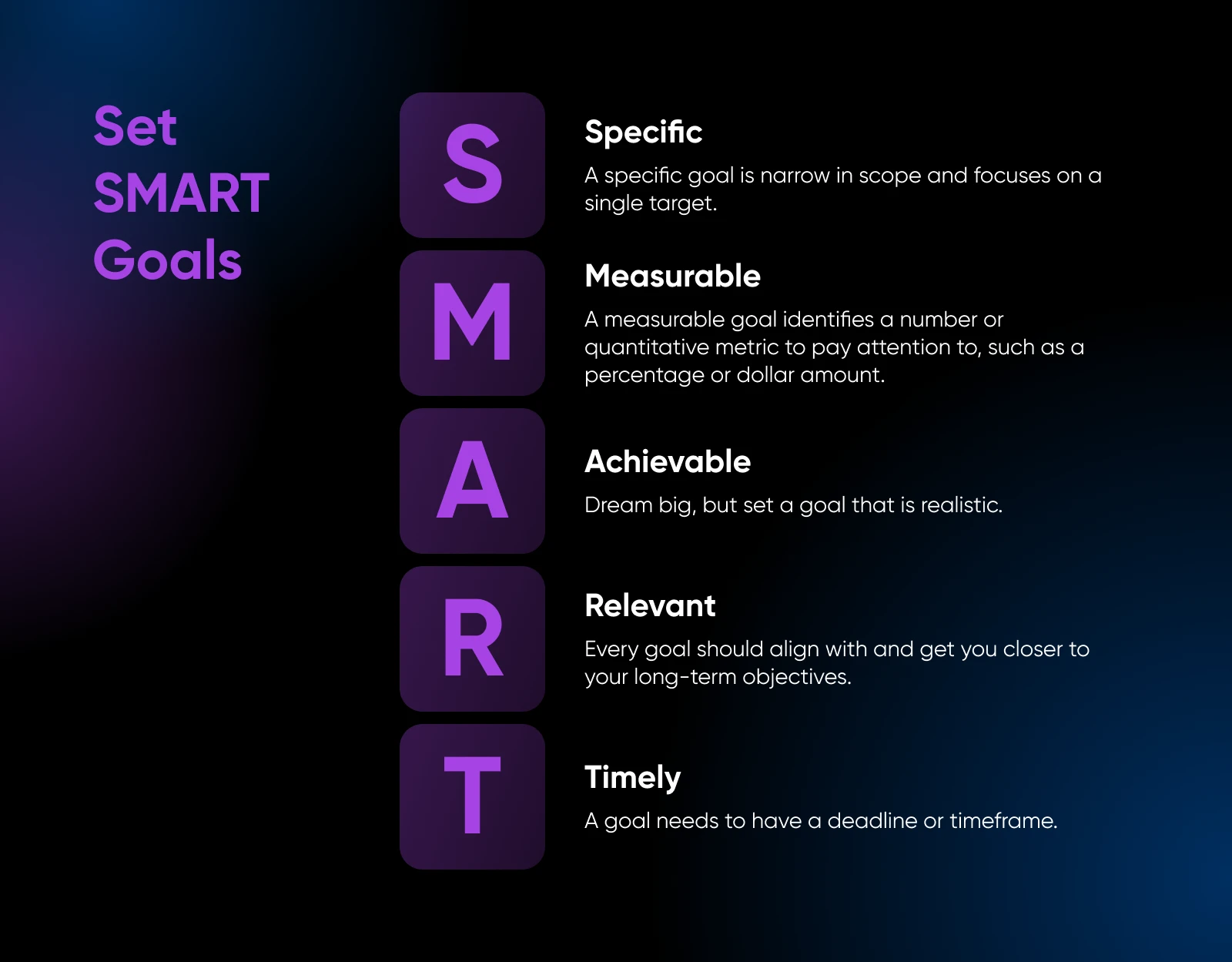
What does that mean? Instead of setting a goal like “grow my business,” you’re going to get a lot more precise: “Increase sales by 25% by the end of Q4.” Now, your goal fulfills the SMART criteria.
To build a plan for growth and expansion, outline a series of these sorts of goals for a period of one or two years. Typically, businesses divide this period into quarters, so you’ll ideally have eight goals for a two-year period.
Need Support Getting Your Business Off The Ground?
Starting a business is typically a long and arduous endeavor.
That said, it’s also incredibly rewarding!
Few things are as satisfying as seeing others enjoy your hard work and benefit from your products and services.
If you’re ready to become a small business owner, DreamHost shared hosting is one of the easiest and most affordable ways to get your website up and running and your idea off the ground.
Our plans give you everything your business needs to thrive online — easy WordPress set up, tons of storage, speed, great reliability and security, and more.
Our Pro Services team takes all those other stresses, from managing your website to maximizing your marketing, off your hands so you can focus on the bigger picture.
While there are no certainties in business, some things are universally true: Whatever happens, you’ll learn a lot as an entrepreneur, and DreamHost has your back every step of the way.

Get More Visitors, Grow Your Business
Our marketing experts will help you earn more traffic and convert more website visitors so you can focus on running your business.
Learn More
